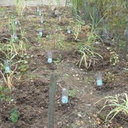Long-term phytomanagement with compost and a sunflower - Tobacco rotation influences the structural microbial diversity of a Cu-contaminated soil.
Kľúčové slová
Abstrakt
At a former wood preservation site contaminated with Cu, various phytomanagement options have been assessed in the last decade through physicochemical, ecotoxicological and biological assays. In a field trial at this site, phytomanagement with a crop rotation based on tobacco and sunflower, combined with the incorporation of compost and dolomitic limestone, has proved to be efficient in Cu-associated risk mitigation, ecological soil functions recovery and net gain of economic and social benefits. To demonstrate the long-term effectiveness and sustainability of phytomanagement, we assessed here the influence of this remediation option on the diversity, composition and structure of microbial communities over time, through a metabarcoding approach. After 9 years of phytomanagement, no overall effect was identified on microbial diversity; the soil amendments, notably the repeated compost application, led to shifts in soil microbial populations. This phytomanagement option induced changes in the composition of soil microbial communities, promoting the growth of microbial groups belonging to Alphaproteobacteria, many being involved in N cycling. Populations of Nitrososphaeria, which are crucial in nitrification, as well as taxa from phyla Planctomycetacia, Chloroflexi and Gemmatimonadetes, which are tolerant to metal contamination and adapted to oligotrophic soil conditions, decreased in amended phytomanaged plots. Our study provides an insight into population dynamics within soil microbial communities under long-term phytomanagement, in line with the assessment of soil ecological functions and their recovery.


